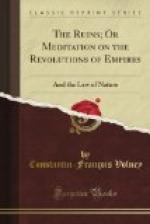** M. Balli, in placing the first astronomers at Selingenakoy, near the Bailkal paid no attention to this twofold circumstance: it equally argues against their being placed at Axoum on account of the rains, and the Zimb fly of which Mr. Bruce speaks.
“It was, then, on the borders of the upper Nile, among a black race of men, that was organized the complicated system of the worship of the stars, considered in relation to the productions of the earth and the labors of agriculture; and this first worship, characterized by their adoration under their own forms and natural attributes, was a simple proceeding of the human mind. But in a short time, the multiplicity of the objects of their relations, and their reciprocal influence, having complicated the ideas, and the signs that represented them, there followed a confusion as singular in its cause as pernicious in its effects.”
III. Third system. Worship of Symbols, or Idolatry.
“As soon as this agricultural people began to observe the stars with attention, they found it necessary to individualize or group them; and to assign to each a proper name, in order to understand each other in their designation. A great difficulty must have presented itself in this business: First, the heavenly bodies, similar in form, offered no distinguishing characteristics by which to denominate them; and, secondly, the language in its infancy and poverty, had no expressions for so many new and metaphysical ideas. Necessity, the usual stimulus of genius, surmounted everything. Having remarked that in the annual revolution, the renewal and periodical appearance of terrestrial productions were constantly associated with the rising and setting of certain stars, and to their position as relative to the sun, the fundamental term of all comparison, the mind by a natural operation connected in thought these terrestrial and celestial objects, which were connected in fact; and applying to them a common sign, it gave to the stars, and their groups, the names of the terrestrial objects to which they answered.*




